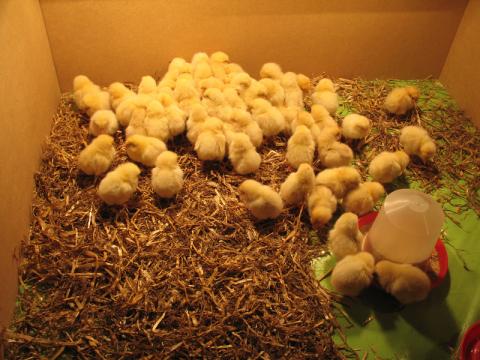My friends, there are no friends

Captivated, the visitors of a fair of Eco-fashion and sustainable design gather around a cardboard box, inside which 61 cute little chicks are scampering about. Meanwhile, on the other side, a girl with a pleasant smile explains to them what her project is about. The chicks, all male, will need the help of those present, if they are not to end up in the shredder. It is a fate that would have been inevitable, had they been left at the poultry farm where the young woman picked them up earlier, and one they would have shared with the 31 million chicks that are born as males each year in the Netherlands. For the duration of the fair, though, their future lies in the hands of anyone willing to purchase one for a modest price.
At the end of the day, only 9 chicks have been bought. For the rest, the fearful moment seems nigh. The deal was made clear, and it doesn't look as if the girl will back down. She assures the public one more time that she herself will put the remaining chicks into the shredder that is standing by, if they do not find a new owner. The crowd becomes agitated and the atmosphere quickly turns sour. But nobody really knows what to do, and the people appear frozen. Then someone steps forward to snatch up the machine, and runs off with it. The girl threatens to smash the chicks against the wall if the shredder is not returned, and it is at this point that the organizers of the fair intervene. They buy up the whole box of creatures, take it to the police station, and have the author of the project arrested.
This is the description of what happened in 2008, in the project “Save the males” by the Dutch artist known as Tinkebell. As all collaborative processes in art this project speaks also of itself, of human relations, its contradictions, and of the place of the individual in a group. We could say that the work plays with the limits of the willingness of those present to participate in a collective project, and exposes the complex dialogue between the politically correct, ideals, responsibility and collaboration in activism.
“Save the males” doesn't aim for an amicable and festive exchange between participants, as do many other projects defined as relational art, that is to say those projects that find their raison d'être in the social relations they represent, produce and provoke. Instead, it seeks friction and dissent between different agents of a group, shaking the fragile pillars that support it; an approach that paradoxically serves, not to destroy it, but to redefine it as a community.
According to the filmmaker Florian Schneider in his article Collaboration: The Dark Side of the Multitude, it is necessary to distinguish between the definitions of collaboration and cooperation, by reexamining the etymological, historical and political significances of the two words. A cooperation is entered into by identifiable individuals, according to romantic notions of affinity and common interests. A collaboration, by contrast, is set up between participants whose motivations doesn't necessarily stem from altruism or generosity at all. It is an ambivalent process made up of a series of paradoxical relations between interdependent co-producers. Recall, for example, the use of collaboration as a pejorative term for the voluntary assistance to an occupying enemy force.
A community may arise out of almost any situation, not even requiring a clear objective. All that it takes is a series of visual identifying signs, or a common adversary, for different individuals to share a sense of complicity between them. What appears more challenging, however, according to already classical sociological studies, is for the collective experience to turn into an emancipating and critical force, instead of a sedative that leads its members to group-think, obedience and laziness.
A sociological experiment realized in the fifties, called the Asch experiment, demonstrated just until which point a group may be subjected to conformity. In this experiment, a number of individuals were asked to take part in a “vision test”. Participants were grouped around a table, concealing the fact that most of them were accomplices to the project. Then, one by one, they were made to answer questions about the length of some lines, which ones were larger than others, which ones equal, etc. The accomplices answered first and, although they started correctly, continued by consequently giving the wrong answers. A high proportion of the rest of the participants imitated their answers, influenced by the unanimity of the responses already given, despite realizing that they were mistaken.
Daily life is full of examples in which decisions are taken as a group, that fail to satisfy anyone individually. Yet they are followed through anyway, in order to please others, or because of the social inhibitions that keep individuals from following their desires more openly.
It isn't always easy to accommodate a disagreement, or to find a place for conflict or dispute, between the members of a group. Nevertheless, many collectives find their raison d'être while in a state of permanent crisis, guided by a paradigm of unity in which the common ground of the agents involved is not based on affinity, nor on consent, but on a contradictory and inconsistent network of personal projects that happen to coincide and challenge each other.
Published in:
- Mugalari, el suplemento cultural del periódico Gara.
Comments
Klaas
Fri, 07/01/2011 - 11:46
Tinkebell on trial
The institutional space par excellence for the ritualised enactment of conflict is the court room. It is therefore with great interest that we follow the proceedings in Tinkebell's trial today, in connection to her project "Save the pets". Good luck!